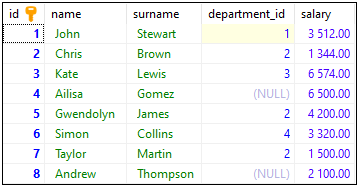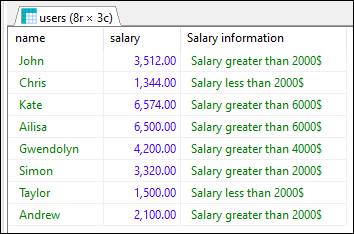EN
MS SQL Server - CASE statement
0
points
In this article, we would like to show you how to use CASE statement in MS SQL Server.
Quick solution:
CASE
WHEN condition1 THEN result1
WHEN condition2 THEN result2
WHEN conditionN THEN resultN
ELSE result
END;
Practical example
To show how the CASE statement works, we will use the following table:

Note:
At the end of this article you can find database preparation SQL queries.
Example
In this example, we will display information about users salary using CASE statement.
Query:
SELECT [name], [salary],
CASE
WHEN [salary] > 6000 THEN 'Salary greater than 6000$'
WHEN [salary] > 4000 THEN 'Salary greater than 4000$'
WHEN [salary] >= 2000 THEN 'Salary greater than 2000$'
ELSE 'Salary less than 2000$'
END AS 'Salary information'
FROM [users];
Output:

Database preparation
create_tables.sql file:
CREATE TABLE [users] (
[id] INT IDENTITY(1,1),
[name] VARCHAR(50) NOT NULL,
[surname] VARCHAR(50) NOT NULL,
[department_id] INT,
[salary] DECIMAL(15,2) NOT NULL,
PRIMARY KEY ([id])
);
insert_data.sql file:
INSERT INTO [users]
( [name], [surname], [department_id], [salary])
VALUES
('John', 'Stewart', 1, '3512.00'),
('Chris', 'Brown', 2, '1344.00'),
('Kate', 'Lewis', 3, '6574.00'),
('Ailisa', 'Gomez', NULL, '6500.00'),
('Gwendolyn', 'James', 2, '4200.00'),
('Simon', 'Collins', 4, '3320.00'),
('Taylor', 'Martin', 2, '1500.00'),
('Andrew', 'Thompson', NULL, '2100.00');